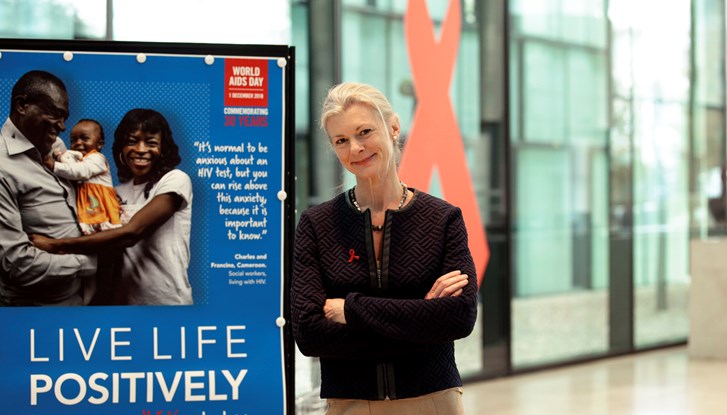World AIDS Day marks its 30th anniversary! This year’s theme is “Know your status”. Significant progress has been made. Today three in four people living with HIV know their status. But the latest UNAIDS report shows that we still face many challenges ahead. Ahead of World AIDS Day, we meet Helena Nygren-Krug, Senior Advisor at UNAIDS, to talk about HIV testing and the role of UNAIDS.

In 2017: 36.9 million people globally were living with HIV. A quarter of all people living with HIV (9.4 million) did not know they have the virus. 21.7 million people were accessing treatment (59% of people living with HIV). 1.8 million people were newly infected with HIV. 940 000 people died from AIDS-related illnessness.
“Knowledge is power” is the key message for this year’s UNAIDS day. Unfortunately, many people still only get tested after becoming ill. Why is that even when effective HIV treatment is available?
The new report shows that stigma, discrimination and other human rights violations still present major barriers. Let’s face it, HIV raises questions that are often considered sensitive even taboo—around gender, sexuality, identity, exclusion, and power. Just being seen accessing HIV services provokes fear among many, women and men.
Overall, barriers to services take many different shapes or forms. When it comes to HIV testing for adolescents, for instance, it can be policies requiring parental consent. For key populations, a major barrier is criminal law. Take the fact that over 70 countries criminalize same-sex relations. How can gay men living in these countries safely access HIV testing, the gateway not only to life-saving treatment but also to effective prevention strategies both for themselves and their loved ones?
It’s shocking that adolescent girls and young women (aged 15–24 years) accounted for one in four HIV infections in 2017, despite being only 10% of the population in sub-Saharan Africa. How can we tackle this problem?
In a nutshell, without the full enjoyment of their human rights, including sexual and reproductive rights, women and girls will remain vulnerable to HIV. In other words, empowering women and girls to protect themselves from HIV demands addressing a range of civil, cultural, economic, political and social rights, including gender equality and freedom from gender-based violence. Harmful traditional practices such as early marriage need to be uprooted and comprehensive sexuality education rolled out in schools and communities everywhere.
But it also means engaging men and boys. We have the data that shows that they are less likely than women and girls to know their HIV status, more likely than women to start HIV treatment late, to interrupt treatment and to be lost to treatment follow-up.
What is the role of UNAIDS as you move ahead towards the ambitious target of ending AIDS by 2030?
UNAIDS is uniquely placed to lead and coordinate the global AIDS response, making sure that all voices are heard and that everyone is reached. It was the first, and remains the only UN agency, where civil society is represented on its board. This helps ensure that HIV policies and programmes are anchored in, and address, the lived realities of affected communities on the ground.
As a Joint Programme consisting of 11 UN agencies, including UNICEF, UNFPA, WHO and the World Bank, we work across different sectors. We support other partners too, such as the Global Fund, especially in the area of strategic information and we also use this information for wider political advocacy and accountability.
As we move ahead toward the goal of ending AIDS, let us use UNAIDS as a pathfinder for wider societal transformation. UNAIDS can help translate the imperative of Agenda 2030 on Sustainable Development “to leave no one behind” into bold and concrete actions.